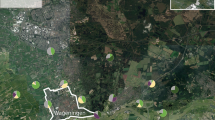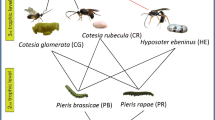Abstract
Invasive insect herbivores have the potential to interfere with native multitrophic interactions by affecting the chemical cues emitted by plants and disrupting the attraction of natural enemies mediated by herbivore-induced plant volatiles (HIPVs). In a previous study, we found that the presence of the exotic herbivore Spodoptera littoralis on Brassica rapa plants infested by the native herbivore Pieris brassicae makes these dually-infested plants unattractive to the main parasitoid of P. brassicae, the braconid wasp Cotesia glomerata. Here we show that this interference by S. littoralis is strongly dependent on the relative densities of the two herbivores. Parasitoids were only deterred by dually-infested plants when there were more S. littoralis larvae than P. brassicae larvae on a plant. Furthermore, the blend of HIPVs emitted by dually-infested plants differed the most from HIPVs emitted by Pieris-infested plants when S. littoralis density exceeded P. brassicae density. We further found that associative learning by the parasitoid affected its preferences: attraction to dually-infested plants increased after parasitoids were presented a P. brassicae caterpillar (rewarding experience) in presence of the odor of a dually-infested plant, but not when presented a S. littoralis caterpillar (non-rewarding experience). A non-rewarding experience prior to the bioassays resulted in a general decrease in parasitoid motivation to respond to plant odors. We conclude that herbivore density and associative learning may play an important role in the foraging behavior of natural enemies in communities, and such effects should not be overlooked when investigating the ecological impact of exotic species on native food webs.




Similar content being viewed by others
References
Beyaert I, Hilker M (2014) Plant odour plumes as mediators of plant–insect interactions. Biol Rev 89:68–81
Bleeker MAK, Smid HM, Steidle JLM, Kruidhof HM, Van Loon JJA, Vet LEM (2006) Differences in memory dynamics between two closely related parasitoid wasp species. Anim Behav 71:1343–1350. doi:10.1016/j.anbehav.2005.09.016
Bruce TJ, Wadhams LJ, Woodcock CM (2005) Insect host location: a volatile situation. Trends Pl Sci 10:269–274
Bukovinszky T, Poelman EH, Kamp A, Hemerik L, Prekatsakis G, Dicke M (2012) Plants under multiple herbivory: consequences for parasitoid search behaviour and foraging efficiency. Anim Behav 83:501–509. doi:10.1016/j.anbehav.2011.11.027
Chabaane Y, Laplanche D, Turlings TC, Desurmont GA (2014) Impact of exotic insect herbivores on native tritrophic interactions: a case study of the African cotton leafworm, Spodoptera littoralis and insects associated with the field mustard Brassica rapa. J Ecol 103:109–117
Chung SH et al (2013) Herbivore exploits orally secreted bacteria to suppress plant defenses. Proc Natl Acad Sci USA 110:15728–15733. doi:10.1073/pnas.1308867110
Costa A, Ricard I, Davison AC, Turlings TC (2010) Effects of rewarding and unrewarding experiences on the response to host-induced plant odors of the generalist parasitoid Cotesia marginiventris (Hymenoptera: Braconidae). J Insect Behav 23:303–318
de Rijk M, Dicke M, Poelman EH (2013) Foraging behaviour by parasitoids in multiherbivore communities. Anim Behav 85:1517–1528. doi:10.1016/j.anbehav.2013.03.034
De Rijk M, Zhang XI, Van Der Loo JAH, Engel BAS, Dicke M, Poelman EH (2016) Density-mediated indirect interactions alter host foraging behaviour of parasitoids without altering foraging efficiency. Ecol Ent. doi:10.1111/een.12325
Desurmont GA et al (2014) Alien interference: disruption of infochemical networks by invasive insect herbivores. Pl Cell Environ 37:1854–1865
Desurmont GA, Laplanche D, Schiestl FP, Turlings TC (2015) Floral volatiles interfere with plant attraction of parasitoids: ontogeny-dependent infochemical dynamics in Brassica rapa. BMC Ecol 15:17
Desurmont GA, Zemanova MA, Turlings TC (2016) The Gastropod Menace: slugs on Brassica plants affect caterpillar survival through consumption and interference with parasitoid attraction. J Chem Ecol 42:183–192
Dicke M, van Loon JJ, Soler R (2009) Chemical complexity of volatiles from plants induced by multiple attack. Nat Chem Biol 5:317–324
Gandhi KJ, Herms DA (2010) Direct and indirect effects of alien insect herbivores on ecological processes and interactions in forests of eastern North America. Biol Invasions 12:389–405
Geervliet JB, Vreugdenhil AI, Dicke M, Vet LE (1998) Learning to discriminate between infochemicals from different plant-host complexes by the parasitoids Cotesia glomerata and C. rubecula. Entomol Exp Appl 86:241–252
Girling RD, Stewart-Jones A, Dherbecourt J, Staley JT, Wright DJ, Poppy GM (2011) Parasitoids select plants more heavily infested with their caterpillar hosts: a new approach to aid interpretation of plant headspace volatiles. Proc R Soc Lond B Biol Sci 278:2646–2653
Giunti G, Canale A, Messing R, Donati E, Stefanini C, Michaud J, Benelli G (2015) Parasitoid learning: current knowledge and implications for biological control. Biol Control 90:208–219
Gols R, Harvey JA (2009) Plant-mediated effects in the Brassicaceae on the performance and behaviour of parasitoids. Phytochem Rev 8:187–206
Gouinguené S, Alborn H, Turlings TC (2003) Induction of volatile emissions in maize by different larval instars of Spodoptera littoralis. J Chem Ecol 29:145–162
Hare JD (2011) Ecological role of volatiles produced by plants in response to damage by herbivorous insects. Annu Rev Entomol 56:161–180
Holopainen JK, Gershenzon J (2010) Multiple stress factors and the emission of plant VOCs. Trends Pl Sci 15:176–184
Horiuchi J-I, Arimura G-I, Ozawa R, Shimoda T, Takabayashi J, Nishioka T (2003) A comparison of the responses of Tetranychus urticae (Acari: Tetranychidae) and Phytoseiulus persimilis (Acari: Phytoseiidae) to volatiles emitted from lima bean leaves with different levels of damage made by T. urticae or Spodoptera exigua (Lepidoptera: Noctuidae). Appl Entomol Zool 38:109–116
Kenis M et al (2009) Ecological effects of invasive alien insects. Biol Invasions 11:21–45
McArt SH, Halitschke R, Salminen J-P, Thaler JS (2013) Leaf herbivory increases plant fitness via induced resistance to seed predators. Ecology 94:966–975
Meiners T, Wäckers F, Lewis WJ (2003) Associative learning of complex odours in parasitoid host location. Chem Senses 28:231–236
Miresmailli S, Gries R, Gries G, Zamar RH, Isman MB (2012) Population density and feeding duration of cabbage looper larvae on tomato plants alter the levels of plant volatile emissions. Pest Manag Sci 68:101–107
Mumm R, Dicke M (2010) Variation in natural plant products and the attraction of bodyguards involved in indirect plant defense The present review is one in the special series of reviews on animal-plant interactions. Can J Zool 88:628–667
Mumm R, Burow M, Bukovinszkine’Kiss G, Kazantzidou E, Wittstock U, Dicke M, Gershenzon J (2008) Formation of simple nitriles upon glucosinolate hydrolysis affects direct and indirect defense against the specialist herbivore, Pieris rapae. J Chem Ecol 34:1311–1321
Niinemets Ü (2010) Mild versus severe stress and BVOCs: thresholds, priming and consequences. Trends Pl Sci 15:145–153
Papaj DR, Snellen H, Swaans K, Vet LE (1994) Unrewarding experiences and their effect on foraging in the parasitic wasp Leptopilina heterotoma (Hymenoptera: Eucoilidae). J Insect Behav 7:465
Ponzio C, Gols R, Weldegergis BT, Dicke M (2014) Caterpillar-induced plant volatiles remain a reliable signal for foraging wasps during dual attack with a plant pathogen or non-host insect herbivore. Pl Cell Environ 37:1924–1935
Rasmann S, Turlings TC (2007) Simultaneous feeding by aboveground and belowground herbivores attenuates plant-mediated attraction of their respective natural enemies. Ecol Lett 10:926–936
Rijk M, Yang D, Engel B, Dicke M, Poelman EH (2016) Feeding guild of non-host community members affects host-foraging efficiency of a parasitic wasp. Ecology 97:1388–1399
Rioja T, Ceballos R, Holuigue L, Vargas R (2016) Different population densities and continuous feeding by Oligonychus yothersi (McGregor)(Acari: Tetranychidae) affect the emissions of herbivore-induced plant volatiles on avocado (Persea americana Mill. cv. Hass) shoots under semi-field conditions. Int J Acarol 42:310–318
Schiestl FP (2010) The evolution of floral scent and insect chemical communication. Ecol Lett 13:643–656. doi:10.1111/j.1461-0248.2010.01451.x
Schiestl FP, Kirk H, Bigler L, Cozzolino S, Desurmont GA (2014) Herbivory and floral signaling: phenotypic plasticity and tradeoffs between reproduction and indirect defense. New Phytol 203:257–266. doi:10.1111/nph.12783
Shiojiri K, Ozawa R, Kugimiya S, Uefune M, van Wijk M, Sabelis MW, Takabayashi J (2010) Herbivore-specific, density-dependent induction of plant volatiles: honest or “cry wolf” signals? PLoS ONE 5:e12161. doi:10.1371/journal.pone.0012161
Smid HM, Wang G, Bukovinszky T, Steidle JLM, Bleeker MAK, van Loon JJA, Vet LEM (2007) Species-specific acquisition and consolidation of long-term memory in parasitic wasps. Proc R Soc Lond B Biol Sci 274:1539–1546. doi:10.1098/rspb.2007.0305
Strauss SY, Agrawal AA (1999) The ecology and evolution of plant tolerance to herbivory. Trends Ecol Evol 14:179–185
Tagawa J (2000) Sex allocation and clutch size in the gregarious larval endoparasitoid wasp, Cotesia glomerata. Entomol Exp App 97:193–202
Takabayashi J, Sabelis M, Janssen A, Shiojiri K, van Wijk M (2006) Can plants betray the presence of multiple herbivore species to predators and parasitoids? The role of learning in phytochemical information networks. Ecol Res 21:3–8. doi:10.1007/s11284-005-0129-7
Ton J, D'alessandro M, Jourdie V, Jakab G, Karlen D, Held M, Mauch-Mani B, Turlings TC (2007) Priming by airborne signals boosts direct and indirect resistance in maize. Plant J 49(1):16–26
Turlings TC, Wäckers F (2004) Recruitment of predators and parasitoids by herbivore-injured plants. Adv Insect Chem Ecol 2:21–75
Turlings TC, Wäckers FL, Vet LE, Lewis WJ, Tumlinson JH (1993) Learning of host-finding cues by hymenopterous parasitoids. In: Papaj DR, Lewis AC (eds) Insect learning. Springer, Boston, MA, pp 51–78
Turlings TC, Davison A, Tamò C (2004) A six-arm olfactometer permitting simultaneous observation of insect attraction and odour trapping. Physiol Entomol 29:45–55
Vet LE, Lewis WJ, Carde RT (1995) Parasitoid foraging and learning. In: Cardé RT, Bell WJ (eds) Chemical ecology of insects 2. Springer, New York, NY, pp 65–101
Vos M, Hemerik L, Vet LE (1998) Patch exploitation by the parasitoids Cotesia rubecula and Cotesia glomerata in multi-patch environments with different host distributions. J Anim Ecol 67:774–783
Wittstock U et al (2004) Successful herbivore attack due to metabolic diversion of a plant chemical defense. Proc Natl Acad Sci USA 101:4859–4864
Acknowledgements
The authors thank Tom de Jong for collecting the B. rapa seeds used in the study. The authors are also thankful to Diane Laplanche, Marie-Jeanne Tschudi, and Xu Hao for their help with growing the B. rapa plants used in the study and maintaining the colonies of P. brassicae and C. glomerata. This study was funded by the Swiss National Science Foundation (FN 31VL30-134413), in the context of the EUROCORES Programme EuroVOL (project InvaVOL) of the European Science Foundation.
Author information
Authors and Affiliations
Corresponding author
Electronic supplementary material
Below is the link to the electronic supplementary material.
Rights and permissions
About this article
Cite this article
Desurmont, G.A., Guiguet, A. & Turlings, T.C.J. Invasive insect herbivores as disrupters of chemically-mediated tritrophic interactions: effects of herbivore density and parasitoid learning. Biol Invasions 20, 195–206 (2018). https://doi.org/10.1007/s10530-017-1526-x
Received:
Accepted:
Published:
Issue Date:
DOI: https://doi.org/10.1007/s10530-017-1526-x




